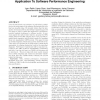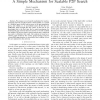475 search results - page 72 / 95 » Formal Analysis of Processor Timing Models |
WOSP
2004
ACM
2004
ACM
From UML activity diagrams to Stochastic Petri nets: application to software performance engineering
14 years 1 months ago
Over the last decade, the relevance of performance evaluation in the early stages of the software development life-cycle has been steadily rising. We honestly believe that the int...
JUCS
2007
13 years 8 months ago
2007
: Nowadays, software evolution is a very hot topic. It is particularly complex when it regards critical and nonstopping systems. Usually, these situations are tackled by hard-codin...
INFOCOM
2009
IEEE
14 years 3 months ago
2009
IEEE
Abstract—We propose a novel search mechanism for unstructured p2p networks, and show that it is both scalable, i.e., it leads to a bounded query traffic load per peer as the pee...
ISSS
2002
IEEE
14 years 1 months ago
2002
IEEE
We have fabricated a Chip Multiprocessor prototype code-named Merlot to proof our novel speculative multithreading architecture. On Merlot, multiple threads provide wider issue wi...
ISCA
1997
IEEE
14 years 20 days ago
1997
IEEE
As processor architectures have increased their reliance on speculative execution to improve performance, the importance of accurate prediction of what to execute speculatively ha...


